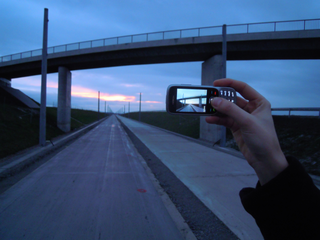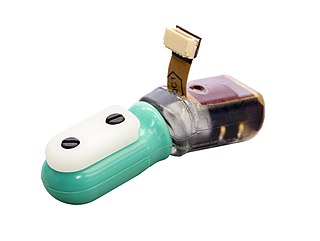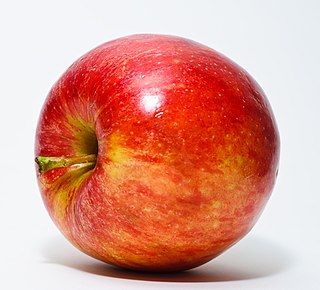Related Research Articles
Abstraction in its main sense is a conceptual process where general rules and concepts are derived from the usage and classification of specific examples, literal signifiers, first principles, or other methods.
Computer vision is an interdisciplinary scientific field that deals with how computers can gain high-level understanding from digital images or videos. From the perspective of engineering, it seeks to understand and automate tasks that the human visual system can do.

The graphical user interface is a form of user interface that allows users to interact with electronic devices through graphical icons and audio indicator such as primary notation, instead of text-based user interfaces, typed command labels or text navigation. GUIs were introduced in reaction to the perceived steep learning curve of command-line interfaces (CLIs), which require commands to be typed on a computer keyboard.

Mechanical engineering is an engineering branch that combines engineering physics and mathematics principles with materials science to design, analyze, manufacture, and maintain mechanical systems. It is one of the oldest and broadest of the engineering branches.

In the industrial design field of human–computer interaction, a user interface (UI) is the space where interactions between humans and machines occur. The goal of this interaction is to allow effective operation and control of the machine from the human end, whilst the machine simultaneously feeds back information that aids the operators' decision-making process. Examples of this broad concept of user interfaces include the interactive aspects of computer operating systems, hand tools, heavy machinery operator controls, and process controls. The design considerations applicable when creating user interfaces are related to, or involve such disciplines as, ergonomics and psychology.

An image is an artifact that depicts visual perception, such as a photograph or other two-dimensional picture, that resembles a subject—usually a physical object—and thus provides a depiction of it. In the context of signal processing, an image is a distributed amplitude of color(s). A pictorial script is a writing system that employs images as symbols for various semantic entities, rather than the abstract signs used by alphabets.
A document is a written, drawn, presented, or memorialized representation of thought, often the manifestation of non-fictional, as well as fictional, content. The word originates from the Latin Documentum, which denotes a "teaching" or "lesson": the verb doceō denotes "to teach". In the past, the word was usually used to denote written proof useful as evidence of a truth or fact. In the computer age, "document" usually denotes a primarily textual computer file, including its structure and format, e.g. fonts, colors, and images. Contemporarily, "document" is not defined by its transmission medium, e.g., paper, given the existence of electronic documents. "Documentation" is distinct because it has more denotations than "document". Documents are also distinguished from "realia", which are three-dimensional objects that would otherwise satisfy the definition of "document" because they memorialize or represent thought; documents are considered more as 2-dimensional representations. While documents can have large varieties of customization, all documents can be shared freely and have the right to do so, creativity can be represented by documents, also. History, events, examples, opinions, etc. all can be expressed in documents.
Realia may refer to:

3D printing, or additive manufacturing, is the construction of a three-dimensional object from a CAD model or a digital 3D model. The term "3D printing" can refer to a variety of processes in which material is deposited, joined or solidified under computer control to create a three-dimensional object, with material being added together, typically layer by layer.
Technology integration is the use of technology tools in general content areas in education in order to allow students to apply computer and technology skills to learning and problem-solving. Generally speaking, the curriculum drives the use of technology and not vice versa. Technology integration is defined as the use of technology to enhance and support the educational environment. Technology integration in the classroom can also support classroom instruction by creating opportunities for students to complete assignments on the computer rather than with normal pencil and paper. In a larger sense, technology integration can also refer to the use of an integration platform and APIs in the management of a school, to integrate disparate SaaS applications, databases, and programs used by an educational institution so that their data can be shared in real-time across all systems on campus, thus supporting students' education by improving data quality and access for faculty and staff.
"Curriculum integration with the use of technology involves the infusion of technology as a tool to enhance the learning in a content area or multidisciplinary setting... Effective integration of technology is achieved when students are able to select technology tools to help them obtain information in a timely manner, analyze and synthesize the information, and present it professionally to an authentic audience. The technology should become an integral part of how the classroom functions—as accessible as all other classroom tools. The focus in each lesson or unit is the curriculum outcome, not the technology."

3D computer graphics, sometimes called CGI, 3DCG or three-dimensional computer graphics, are graphics that use a three-dimensional representation of geometric data that is stored in the computer for the purposes of performing calculations and rendering 2D images. The resulting images may be stored for viewing later or displayed in real time. Unlike 3D film and similar techniques, the result is two-dimensional, without the illusion of being solid.

Computer graphics deals with generating images with the aid of computers. Today, computer graphics is a core technology in digital photography, film, video games, cell phone and computer displays, and many specialized applications. A great deal of specialized hardware and software has been developed, with the displays of most devices being driven by computer graphics hardware. It is a vast and recently developed area of computer science. The phrase was coined in 1960 by computer graphics researchers Verne Hudson and William Fetter of Boeing. It is often abbreviated as CG, or typically in the context of film as computer generated imagery (CGI). The non-artistic aspects of computer graphics are the subject of computer science research.

A drafter, draughtsman/draughtswoman, draftsman/draftswoman, drafting technician is an engineering technician who makes detailed technical drawings or plans for machinery, buildings, electronics, infrastructure, sections, etc. Drafters use computer software and manual sketches to convert the designs, plans, and layouts of engineers and architects into a set of technical drawings. Drafters operate as the supporting developers and sketch engineering designs and drawings from preliminary design concepts.
Reference is a relationship between objects in which one object designates, or acts as a means by which to connect to or link to, another object. The first object in this relation is said to refer to the second object. It is called a name for the second object. The second object, the one to which the first object refers, is called the referent of the first object. A name is usually a phrase or expression, or some other symbolic representation. Its referent may be anything – a material object, a person, an event, an activity, or an abstract concept.
In computing, 3D interaction is a form of human-machine interaction where users are able to move and perform interaction in 3D space. Both human and machine process information where the physical position of elements in the 3D space is relevant.
In library classification systems, realia are three-dimensional objects from real life such as coins, tools, and textiles, that do not fit into the traditional categories of library material. They can be either man-made or naturally occurring, usually borrowed, purchased, or received as donation by a teacher, library, or museum for use in classroom instruction or in exhibits. Archival and manuscript collections often receive items of memorabilia such as badges, emblems, insignias, jewelry, leather goods, needlework, etc., in connection with gifts of personal papers. Most government or institutional archives reject gifts of non-documentary objects unless they have a documentary value. When accepting large bequests of mixed objects they normally have the donors sign legal documents giving permission to the archive to destroy, exchange, sell or dispose in any way those objects which, according to the best judgement of the archivist, are not manuscripts or are not immediately useful for understanding the manuscripts. Recently, the usage of this term has been criticized by librarians based on the usage of term realia to refer to artistic and historical artifacts and objects, and suggesting the use of the phrase "real world object" to describe the broader categories of three-dimensional objects in libraries.
In education, realia are objects from real life used in classroom instruction by educators to improve students' understanding of other cultures and real-life situations. A teacher of a foreign language often employs realia to strengthen students' associations between words for common objects and the objects themselves. In many cases, these objects are part of an instructional kit that includes a manual and is thus considered as being part of a documentary whole by librarians.

A tactile sensor is a device that measures information arising from physical interaction with its environment. Tactile sensors are generally modeled after the biological sense of cutaneous touch which is capable of detecting stimuli resulting from mechanical stimulation, temperature, and pain. Tactile sensors are used in robotics, computer hardware and security systems. A common application of tactile sensors is in touchscreen devices on mobile phones and computing.

In 3D computer graphics, 3D modeling is the process of developing a mathematical coordinate-based representation of any surface of an object in three dimensions via specialized software. The product is called a 3D model. Someone who works with 3D models may be referred to as a 3D artist or a 3D modeler. A 3D Model can also be displayed as a two-dimensional image through a process called 3D rendering or used in a computer simulation of physical phenomena. The 3D model can be physically created using 3D printing devices that form 2D layers of the model with three-dimensional material, one layer at a time. In terms of game development, 3D modeling is merely a stage in the entire development process. Simply put, the source of the geometry for the shape of an object can be 1. A designer, industrial engineer or artist using a 3D-CAD system, 2. An existing object, reverse engineered or copied using a 3-D shape digitizer or scanner or 3. Mathematical data stored in memory based on an numerical description or calculation the object.

A surface, as the term is most generally used, is the outermost or uppermost layer of a physical object or space. It is the portion or region of the object that can first be perceived by an observer using the senses of sight and touch, and is the portion with which other materials first interact. The surface of an object is more than "a mere geometric solid", but is "filled with, spread over by, or suffused with perceivable qualities such as color and warmth".
References
- 1 2 Simpson, Jessica (2019-07-01). "Real World Objects: Conceptual Framework and University Library Consortium Study". The Journal of Academic Librarianship. 45 (4): 332–342. doi: 10.1016/j.acalib.2019.05.003 . ISSN 0099-1333.
- ↑ Coyle, Karen (2015-01-16). "Coyle's InFormation: Real World Objects". Coyle's InFormation. Retrieved 2019-09-11.
- ↑ Engaging the Senses : Object-Based Learning in Higher Education. Chatterjee, Helen J., Hannan, Leonie. Farnham, Surrey, England. 2015-11-28. ISBN 9781472446152. OCLC 915510062.CS1 maint: others (link)